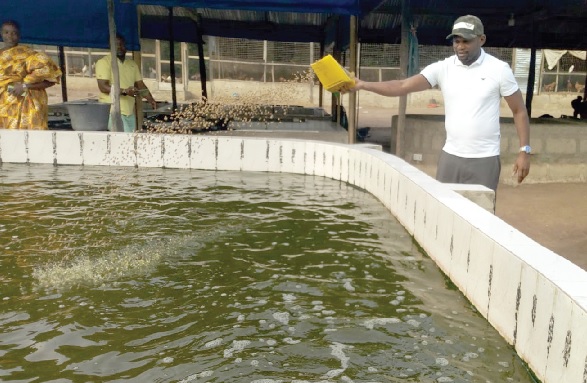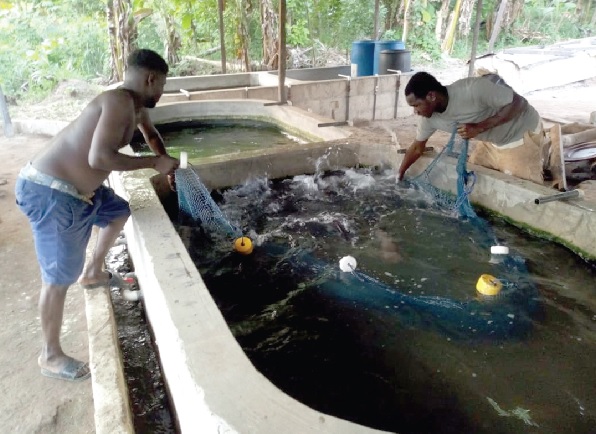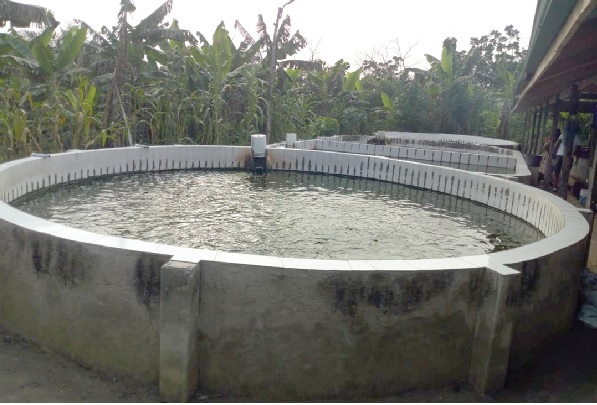Bono East introduces steps to boost fish production
THE Bono East Regional Fisheries Commission is aggressively introducing and implementing new interventions and special projects to boost fish production in the newly created region.
In line with that, the commission is currently training fish farmers to produce fingerlings, formulate and produce local fish feed to reduce cost and educate fish farmers on proper and hygienic handling of fish, particularly fingerlings.
Additionally, the region is actively participating in the government’s flagship programme, “Aquaculture for Food and Jobs”, which was instituted to promote aquaculture production and create jobs for the teeming youth.
Other interventions include the recruitment of new fish farmers to increase the farmer population and train them on how to market their products, among others.
Statistics available from the Bono East Regional Fisheries Commission indicate that the region produced 77.93 Metric Tonnes (MT) of fish in 2021, out of the national production of 89,375.48 MT, but that declined to 36.2 MT in 2022.
The Bono East Regional Director of the Fisheries Commission, Richard Ametorwosor, told the Daily Graphic that the 2022 national aquaculture production figure was, however, yet to be certified by the Food and Agriculture Organisation (FAO).
Fish districts, zones
The region, with 11 administrative municipal and district areas, has seven of its areas engaged in fish production, but in small quantities.
The areas are the Techiman Municipality, Techiman North District, Nkoranza Municipality, Nkoranza North District, Kintampo Municipality, Kintampo South District and Atebubu-Amantin Municipality.

The Atebubu-Amantin Municipality was, however, introduced to fish farming this year.
The region has zoned the fish production districts into four zones.
They are the Techiman Zone, made up of Techiman Municipality and Techiman North District, and the Nkoranza Zone, consisting of Nkoranza Municipality and the Nkoranza North District.
Others are the Kintampo Zone, comprising the Kintampo Municipality and Kintampo South District, as well as the Atebubu-Amantin Zone.
In 2022, the region produced a total of 36.2 MT, with the Techiman Zone producing 21.3 MT of fish made up of 5.30 MT of tilapia and 16 MT of catfish.
The Nkoranza Zone also produced a total of 7.2 MT of fish made up of 1.5 MT of tilapia and five MT of catfish while the Kintampo Zone produced 7.7 MT of fish made up of 2.7 MT of tilapia and five MT of catfish.
In all, there are 104 fish farmers and 213 fishponds in the four fish production zones of the region.

The Techiman Zone has 49 farmers with 130 fishponds; the Nkoranza Zone has 30 farmers with 26 fishponds; and Atebubu-Amantin, which was introduced to fish farming this year, has two farmers with three fishponds.
The rest of the districts, such as Sene East, Sene West, Pru East and Pru West, are not into aquaculture fish production.
The four districts that lie in the lower basin of the Volta Lake rely on the lake for fish.
However, the commission said it was putting measures in place to introduce the districts to fish farming, in order to reduce hardship on the fisher folks during the closed seasons.
Visit
When the Daily Graphic visited the 2023 Bono East Regional Best Fish Farmer, Kelvin Williams Asuma's farm, named “Eagles Croft” at Akisimasu in the Techiman Municipality, it found that he has established about 20 fishponds fully stocked with catfish.
In each fishpond, there are more than 2,000 fish ready for the market. The catfish takes between four to six months to get ready for the market.
He also has eight mini ponds purposely for the production of fingerlings to feed his farm and other fish farmers in the region and other parts of the country.
The Eagles Croft fish farm produces only catfish in commercial quantities and processes them through smoking, frying or salting based on the consumer’s preference.
Last year, Eagles Croft processed more than two MT of catfish and five MT of fresh fish for the market, both in and outside of the country.
Currently, Eagles Croft is a major hatcher, breeder and off-taker for catfish farmers and is providing readily available fingerlings for production in the area.
There are six staff at the farm and the farm has created indirect employment for more than 150 people.
Target
Mr Asuma, who is a staff of the Bui Power Authority (BPA) where he serves as the Community Relations Officer in charge of the Mitigation of the Social Expenses of the Bui Dam's Livelihoods and Restoration of Affected Communities, told the Daily Graphic that in the next three years, he plans to establish a fish processing factory and increasing his workforce to about 500 people in order to increase his production.
He has projected to create departments such as a hatchery, processing departments for fish smokers, salters, fryers of fresh catfish and marketing departments to ensure better management of the company.

Mr Asuma explained that he was only into catfish production because rearing them was economical, while fish farming was a lucrative venture which needed to be supported by the government to entice the youth to venture into the industry.
"Fish farming can contribute immensely to the growth of the country's economy if the government pays more attention to both fish farming and processing," he said.
Halt importation
Mr Asuma urged the government to halt the importation of sardine, mackerels and other fish products and invest heavily in the fisheries sector to make it vibrant in order to feed the country.
"I am appealing to the government to pay more attention to aquaculture to feed the country and stop the importation of fresh and canned fish since the sector has no off-season," he said.
Mr Asuma also appealed to the government to support fish farmers to establish fish feeding and processing factories.
He advised the public, particularly those in the fishing industry, to not solely depend on wild fish, but invest in fish farming to help them have more catch during off-seasons.
Production cost
Mr Asuma, however, expressed concern about the high cost of production, explaining that fish feed had been increased from GH¢120 per bag in 2022 to GH¢275 this year.
He said one of the major challenges facing the industry was the high cost of feed because fish farmers do not have feed processing factories to produce locally for their farms.
He, therefore, called on the government to subsidise the feed for farmers.

Mr Asuma said despite the high cost of production, he had reduced the price of his produce to encourage fish consumption.
He said one needed to have about 70 per cent of the proposed budget before starting fish farming.
Mr Asuma advised fish farmers to devote more time to monitoring the fish, especially at the younger stage, to help early detection of diseases to avoid outbreaks.
Appeal
For her part, the 2020 regional Best Farmer from Nkoranza, Haggai Foriwaah, appealed to the government to establish fish storage facilities in the fish production areas to avoid post-harvest losses.
She also called on the government to put measures in place to facilitate the selling of the fish.
She explained that some of the fish farmers had to go through a lot of frustrations before getting buyers to patronise their produce.
Mrs Foriwaah expressed the need for the government to support fish farmers with fish feed and other logistics to improve their production.
She said she had been in the industry for more than 13 years, adding that fish farming was profitable.
Investment
On the issue of the ban on the importation of fish, the Regional Director of the Fisheries Commission, Mr Ametorwosor, said the call was in the right direction, but argued that more investment should be made to increase production before imposing the ban on fish importation.
He mentioned the high cost of feeding, lack of market, lack of hatchery machines and lack of knowledge in fish farming as some of the challenges facing the industry.
Writer’s email: biiya.ali@graphic.com.gh
